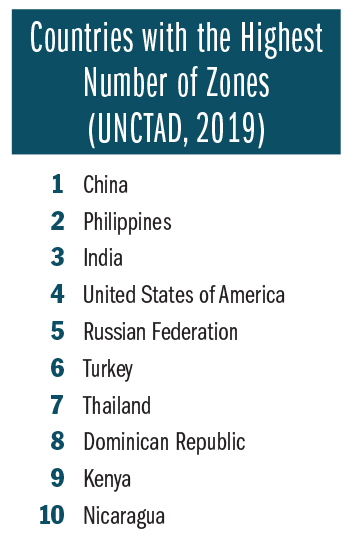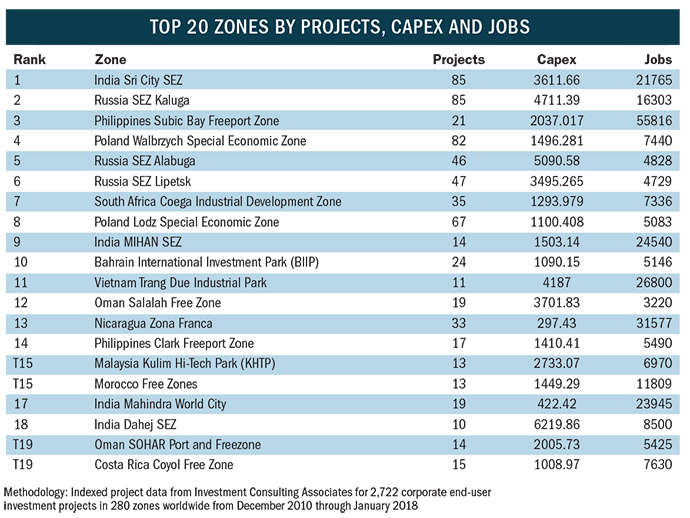Free Trade Zones (FTZs) and Special Economic Zones (SEZs) come in many varieties, sizes and structures. Their commonality is their defined perimeter and their provision of a unique regulatory setup for business and investors separate from the rest of the economies in which they operate.
When the first Zone began operations in 1970, the focus was on providing financial incentives in the form of tax cuts and relief from custom duties. However, as the number of Zones and competition amongst Zones increases, Zones have focused their policies on offering fiscal incentives such as business-friendly regulations, business facilitation services and infrastructure support.

The number of Zones has been increasing in both developing and developed economies, but so have the challenges due to sustainable development demands, the new industrial revolution (Industry 4.0) and the changing political and economic patterns of international production.
UNCTAD’s 2019 World Investment Report shows that between 2014 & 2018, the number of Zones worldwide increased by 26% to around 5,400. More than 140 countries, which include almost 75% of all developing economies and almost all transitioning economies, are home to some form of Zone. In addition, more than 500 Zones are currently in the pipeline — either being developed or developed but not yet operational.
The type of Zones and the objectives which a government would like to achieve with Zones depend on the state of the economy. For example, high-income economies typically focus on innovation hubs and providing efficient platforms to increasingly harness the opportunities of Industry 4.0. Meanwhile, low-income economies focus on achieving industrial development and diversification through the provision of high-quality infrastructure support and low-cost resources to companies within multiple industries.
From Enclave to Catalyst
As policy makers continue to push and implement Zones globally, the challenges faced by Zones are increasing. Despite huge amounts of private and public funds being spent on these initiatives, many Zones remain either empty developments or foreign enclaves within an economy without enough linkages or spill-overs to the local economy.
First, climate change and environmental concerns have pushed modern Zones to consider sustainability as a main pillar of their performance and their contribution to the countries’ industrial base.
The new industrial revolution, commonly referred to as “Industry 4.0,” poses other challenges. Industry 4.0, defined by the trend toward automation and data exchange in manufacturing technologies and processes, continuous to revolutionize the way we live, work and do business, as well as disrupt industries. Industry 4.0 triggers companies to locate in regions where highly skilled talent want to live or work, rather than locations where local labor is cheap. Adjusting and implementing policies and services based on the new needs and requirements by Industry 4.0 will allow Zones to remain competitive and attract more investment.
One example is incentives and services focused on R&D spending support, credit support for training and talent development and creating adequate networks to build strategic partnerships between companies operating in Zones or across different Zones. One example of the many global initiatives to adapt to Industry 4.0 is the Dubai Media Commodities Centre. DMCC provides a complete online and digital process for all members to improve efficiency and enhance connectivity.
Global political uncertainty in its various forms is challenging the policy environment for trade and investment. Protectionism is rising around the world and slowly but surely, we see the era of globalization reversing. Hence for Zones it also becomes critical to cooperate and collaborate.
As global competition increases, Zones should increasingly differentiate themselves in terms of high-class services they can provide to investors. These services move beyond the financial and fiscal incentive packages which are most commonly provided to investors. The future of Zones should be more focused on more inclusive, locally tailored and innovative incentives, high-class services and on environmental challenges rather than just providing financial incentives to attract investors.
The Zones that have done so successfully feature most prominently among this year’s rankings in Site Selection Magazine. We are sure that more Zones will follow the same path and be as successful as some of the No. 1 ranked Zones around the world.

